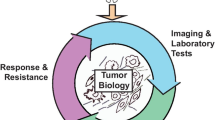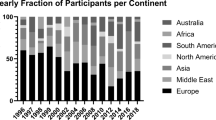Abstract
Modern cancer research, and the wealth of data across multiple spatial and temporal scales, has created the need for researchers that are well versed in the life sciences (cancer biology, developmental biology, immunology), medical sciences (oncology) and natural sciences (mathematics, physics, engineering, computer sciences). College undergraduate education traditionally occurs in disciplinary silos, which creates a steep learning curve at the graduate and postdoctoral levels that increasingly bridge multiple disciplines. Numerous colleges have begun to embrace interdisciplinary curricula, but students who double major in mathematics (or other quantitative sciences) and biology (or medicine) remain scarce. We identified the need to educate junior and senior high school students about integrating mathematical and biological skills, through the lens of mathematical oncology, to better prepare students for future careers at the interdisciplinary interface. The High school Internship Program in Integrated Mathematical Oncology (HIP IMO) at Moffitt Cancer Center has so far trained 59 students between 2015 and 2019. We report here on the program structure, training deliverables, curriculum and outcomes. We hope to promote interdisciplinary educational activities early in a student’s career.



Similar content being viewed by others
References
Altrock PM, Liu LL, Michor F (2015) The mathematics of cancer: integrating quantitative models. Nat Rev Cancer 15:730–745
Altrock PM, Ferlic J, Galla T, Tomasson MH, Michor F (2018) Computational model of progression to multiple myeloma identifies optimum screening strategies. JCO Clin Cancer Inform 2:1–12
Anderson AR, Quaranta V (2008) Integrative mathematical oncology. Nat Rev Cancer 8:227–234
Andor N, Maley CC, Ji HP (2017) Genomic instability in cancer: teetering on the limit of tolerance. Cancer Res 77:2179–2185
Andor N, Simonds EF, Czerwinski DK, Chen J, Grimes SM, Wood-Bouwens C et al (2019) Single-cell RNA-Seq of follicular lymphoma reveals malignant B-cell types and coexpression of T-cell immune checkpoints. Blood 133:1119–1129
Araujo A, Cook LM, Lynch CC, Basanta D (2014) An integrated computational model of the bone microenvironment in bone-metastatic prostate cancer. Cancer Res 74:2391–2401
Basanta D, Anderson ARA (2013) Exploiting ecological principles to better understand cancer progression and treatment. Interface Focus 3:20130020
Basanta D, Gatenby RA, Anderson ARA (2012) Exploiting evolution to treat drug resistance: combination therapy and the double bind. Mol Pharm 9:914–921
Benzekry S, Lamont C, Beheshti A, Tracz A, Ebos JML, Hlatky L et al (2014) Classical mathematical models for description and prediction of experimental tumor growth. PLoS Comput Biol 10:e1003800
Bhatt P, Kambara M, Pilon-Thomas S, Rejniak KA, Chamseddine IM (2019) Modeling vaccine-induced immunotherapy: treatment scheduling and robustness with virtual mice cohorts. BioRxiv, pp 740878
Brady R, Enderling H (2019) Mathematical models of cancer: when to predict novel therapies, and when not to. Bull Math Biol 81:3722–3731
Bravo R, Baratchart E, West J, Schenck RO, Miller AK, Gallaher J et al (2018) Hybrid automata library: a modular platform for efficient hybrid modeling with real-time visualization. BioRxiv, pp 411538
Enderling H, Chaplain MAJ (2014) Mathematical modeling of tumor growth and treatment. Curr Pharm Des 20:4934–4940
Enderling H, Alfonso JCL, Moros E, Caudell JJ, Harrison LB (2019) Integrating mathematical modeling into the roadmap for personalized adaptive radiation therapy. Trends Cancer 5:467–474
Enriquez-Navas PM, Kam Y, Das T, Hassan S, Silva A, Foroutan P et al (2016) Exploiting evolutionary principles to prolong tumor control in preclinical models of breast cancer. Sci Transl Med 8:327ra24
Ferrall-Fairbanks MC, Glazar DJ, Brady RJ, Kimmel GJ, Zahid MU, Altrock PM et al (2019) Re: Simulation analysis for tumor radiotherapy based on three-component mathematical models. J Appl Clin Med Phys 20:204–205
Gatenby R, Brown J (2017) The evolution and ecology of resistance in cancer therapy. Csh Perspect Med 8:a033415
Gatenby RA, Zhang J, Brown JS (2019a) First strike–second strike strategies in metastatic cancer: lessons from the evolutionary dynamics of extinction. Cancer Res 79:3174–3177
Gatenby RA, Artzy-Randrup Y, Epstein T, Reed DR, Brown JS (2019b) Eradicating metastatic cancer and the eco-evolutionary dynamics of Anthropocene extinctions. Cancer Res 80:613–623
Gerlee P (2013) The model muddle: in search of tumor growth laws. Cancer Res 73:2407–2411
Hanahan D, Weinberg RA (2000) The hallmarks of cancer. Cell 100:57–70
Hanahan D, Weinberg RA (2011) Hallmarks of cancer: the next generation. Cell 144:646–674
Howard R, Scheiner A, Cunningham J, Gatenby R (2019a) Cytoplasmic convection currents and intracellular temperature gradients. PLoS Comput Biol 15:e1007372
Howard R, Scheiner A, Kanetsky PA, Egan KM (2019b) Sociodemographic and lifestyle factors associated with the neutrophil-to-lymphocyte ratio. Ann Epidemiol 38:11–21
Kandru R, Desai B (2019) The pipeline for digital analysis of IHC images from NSCLC xenograft tissues. BioRxiv, pp 826545
Karolak A, Markov DA, McCawley LJ, Rejniak KA (2018) Towards personalized computational oncology: from spatial models of tumour spheroids, to organoids, to tissues. J R Soc Interface 15:20170703
Karolak A, Poonja S, Rejniak KA (2019a) Morphophenotypic classification of tumor organoids as an indicator of drug exposure and penetration potential. PLoS Comput Biol 15:e1007214
Karolak A, Agrawal S, Lee S, Rejniak KA (2019b) Single-cell-based in silico models: a tool for dissecting tumor heterogeneity. In: Narayan S (ed) Encyclopedia biomedical engineering, vol 3. Elsevier, pp 130–143
Kaznatcheev A, Peacock J, Basanta D, Marusyk A, Scott JG (2019) Fibroblasts and alectinib switch the evolutionary games played by non-small cell lung cancer. Nat Ecol Evol 3:450–456
Marusyk A, Tabassum DP, Altrock PM, Almendro V, Michor F, Polyak K (2014) Non-cell-autonomous driving of tumour growth supports sub-clonal heterogeneity. Nature 514:54–58
Marusyk A, Tabassum DP, Janiszewska M, Place AE, Trinh A, Rozhok AI et al (2016) Spatial proximity to fibroblasts impacts molecular features and therapeutic sensitivity of breast cancer cells influencing clinical outcomes. Cancer Res 76:6495–6506
Otto SP, Day T (2007) A biologist’s guide to mathematical modeling in ecology and evolution. Princeton University Press, Princeton, pp 692–694
Park DS, Robertson-Tessi M, Luddy KA, Maini PK, Bonsall MB, Gatenby RA et al (2019) The goldilocks window of personalized chemotherapy: getting the immune response just right. Cancer Res 79:5302–5315
Poleszczuk J, Luddy K, Chen L, Lee JK, Harrison LB, Czerniecki BJ et al (2017) Neoadjuvant radiotherapy of early-stage breast cancer and long-term disease-free survival. Breast Cancer Res 19:75
Silva A, Silva MC, Sudalagunta P, Distler A, Jacobson T, Collins A et al (2017) An ex vivo platform for the prediction of clinical response in multiple myeloma. Cancer Res 77:3336–3351
Stanková K, Brown JS, Dalton WS, Gatenby RA (2019) Optimizing cancer treatment using game theory. JAMA Oncol 5:96
Sudalagunta PR, Canevarolo RR, Silva MDCS, Meads MB, Tungesvik A, Avila GD et al (2018) Pharmacodynamical modeling of two-way synergistic effect for high-throughput drug combination screening in an ex vivo reconstruction of bone marrow using primary multiple myeloma cells. Blood 132:1919
Sunassee ED, Tan D, Ji N, Brady R, Moros EG, Caudell JJ et al (2019) Proliferation saturation index in an adaptive Bayesian approach to predict patient-specific radiotherapy responses. Int J Radiat Biol 95(10):1421–1426
Vitos N, Chen S, Mathur S, Chamseddine I, Rejniak KA (2019) Hypoxia in cancer chemo- and immunotherapy: Foe or friend?. BioRxiv, pp 629907
Walker R, Enderling H (2016) From concept to clinic: mathematically informed immunotherapy. Curr Prob Cancer 40:68–83
Walker R, Mejia J, Lee JK, Pimiento JM, Malafa M, Giuliano AR et al (2019) Personalizing gastric cancer screening with predictive modeling of disease progression biomarkers. Appl Immunohistochem Mol Morphol 27:270–277
Warman P, Araujo A, Lynch C, Basanta D (2015) IMO-HIP 2015 report: an evolutionary game theory approach to evolutionary-enlightened application of chemotherapy in bone metastatic prostate cancer. BioRxiv, pp 030262
Warman PI, Kaznatcheev A, Araujo A, Lynch CC, Basanta D (2018) Fractionated follow-up chemotherapy delays the onset of resistance in bone metastatic prostate cancer. Games 9:19
West JB, Dinh MN, Brown JS, Zhang J, Anderson AR, Gatenby RA (2019) Multidrug cancer therapy in metastatic castrate-resistant prostate cancer: an evolution-based strategy. Clin Cancer Res Official J Am Assoc Cancer Res 25:4413–4421
Wilkie KP, Hahnfeldt P (2013) Tumor-immune dynamics regulated in the microenvironment inform the transient nature of immune-induced tumor dormancy. Cancer Res 73:3534–3544
Yagawa Y, Robertson-Tessi M, Zhou SL, Anderson ARA, Mulé JJ, Mailloux AW (2017) Systematic screening of chemokines to identify candidates to model and create ectopic lymph node structures for cancer immunotherapy. Sci Rep UK 7:15996
Zhang J, Cunningham JJ, Brown JS, Gatenby RA (2017) Integrating evolutionary dynamics into treatment of metastatic castrate-resistant prostate cancer. Nat Commun 8:1816
Acknowledgements
HIP IMO is supported by NIH/NCI U54CA143970-05 (Physical Science Oncology Network) “Cancer as a complex adaptive system.” HIP IMO scholars are generously supported by the Richard O. Jacobson Foundation. In-kind support is provided by the West Wing Hotel and the Museum of Sciences and Industry (MOSI). HIP IMO is grateful to Mehdi Damaghi, Asmaa El-Kenawi, Prabakaran Soundararajan, Dung-Tsa Chao, Michal Tomaszewski, Mark Robertson-Tessi for teaching HIP IMO boot camps and classes and the dedicated student and postdoctoral mentors for HIP IMO scholars (Etienne Baratchart, Renee Brady-Nicholls, Rafael Bravo, Ibrahim M. Chamseddine, Andrew Dhawan, Bina Desai, Meghan Ferrall-Fairbanks, Jill Gallaher, Daniel Glazar, Chandler Gatenbee, Rachel Howard, Aleksandra Karolak, Eunjung Kim, Gregory Kimmel, Anna Miller, Rafael Renatino Canevarolo, Jacob Scott, Praneeth Sudalagunta, Enakshi Sunassee, Robert Vander Velde, Jeffrey West, Mohammad Zahid). The authors are thankful to Daniel Glazar and Stefano Pasetto for statistical analysis of HIP IMO survey results. HIP IMO is especially thankful to Danae Paris for administrating the program, and support from the HCPS superintendent Jeff Eakins, HCPS Director for K-12 STEM Education Larry R. Plank, as well as Moffitt PSOC patient advocates Jeri Francoeur and Robert Butler. HIP IMO could not fully function without the critical infrastructure support from MCC and its continued commitment to educating the next generation of scientists.
Author information
Authors and Affiliations
Corresponding author
Additional information
Publisher's Note
Springer Nature remains neutral with regard to jurisdictional claims in published maps and institutional affiliations.
Rights and permissions
About this article
Cite this article
Enderling, H., Altrock, P.M., Andor, N. et al. High School Internship Program in Integrated Mathematical Oncology (HIP IMO): Five-Year Experience at Moffitt Cancer Center. Bull Math Biol 82, 91 (2020). https://doi.org/10.1007/s11538-020-00768-1
Received:
Accepted:
Published:
DOI: https://doi.org/10.1007/s11538-020-00768-1




